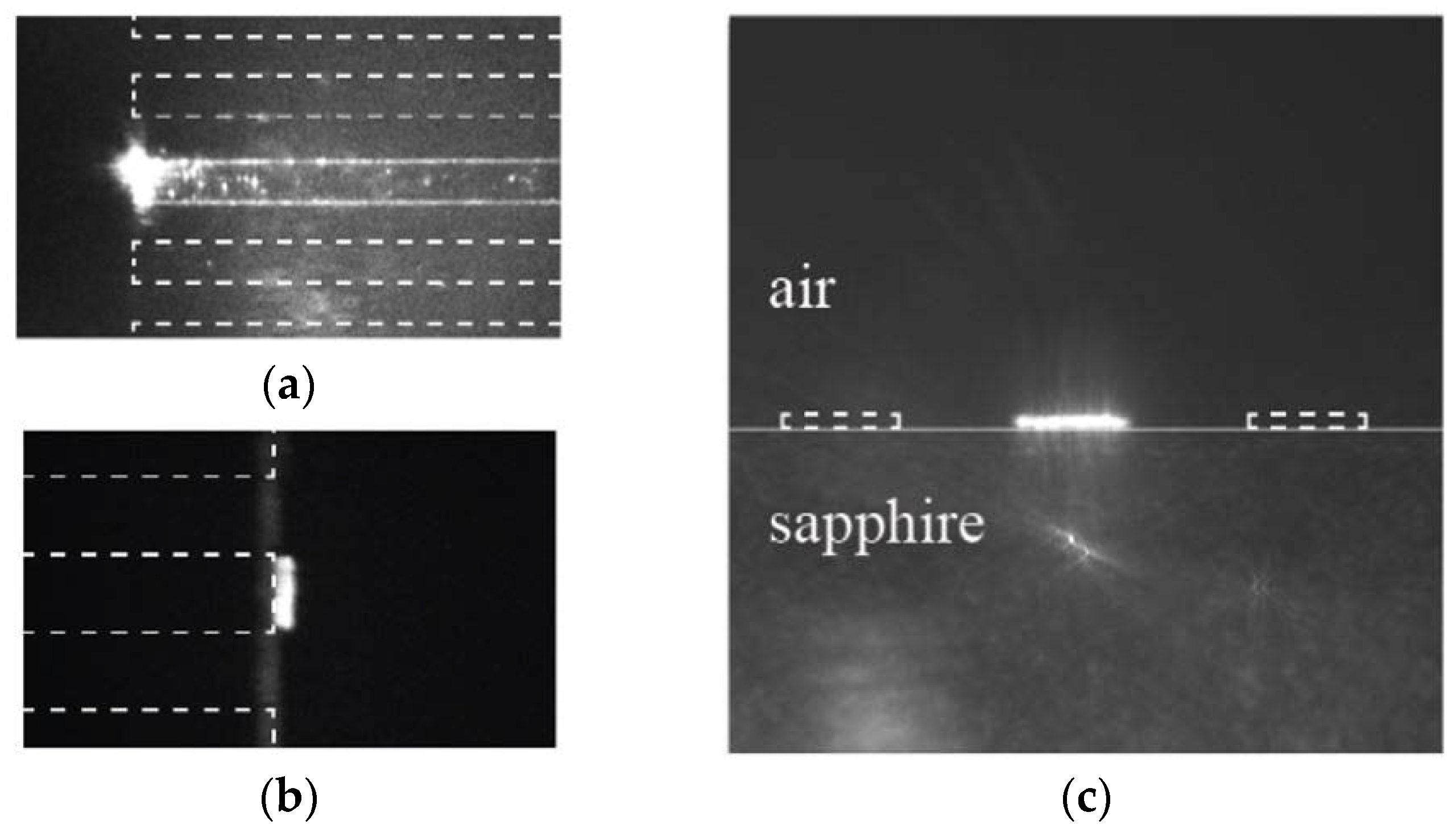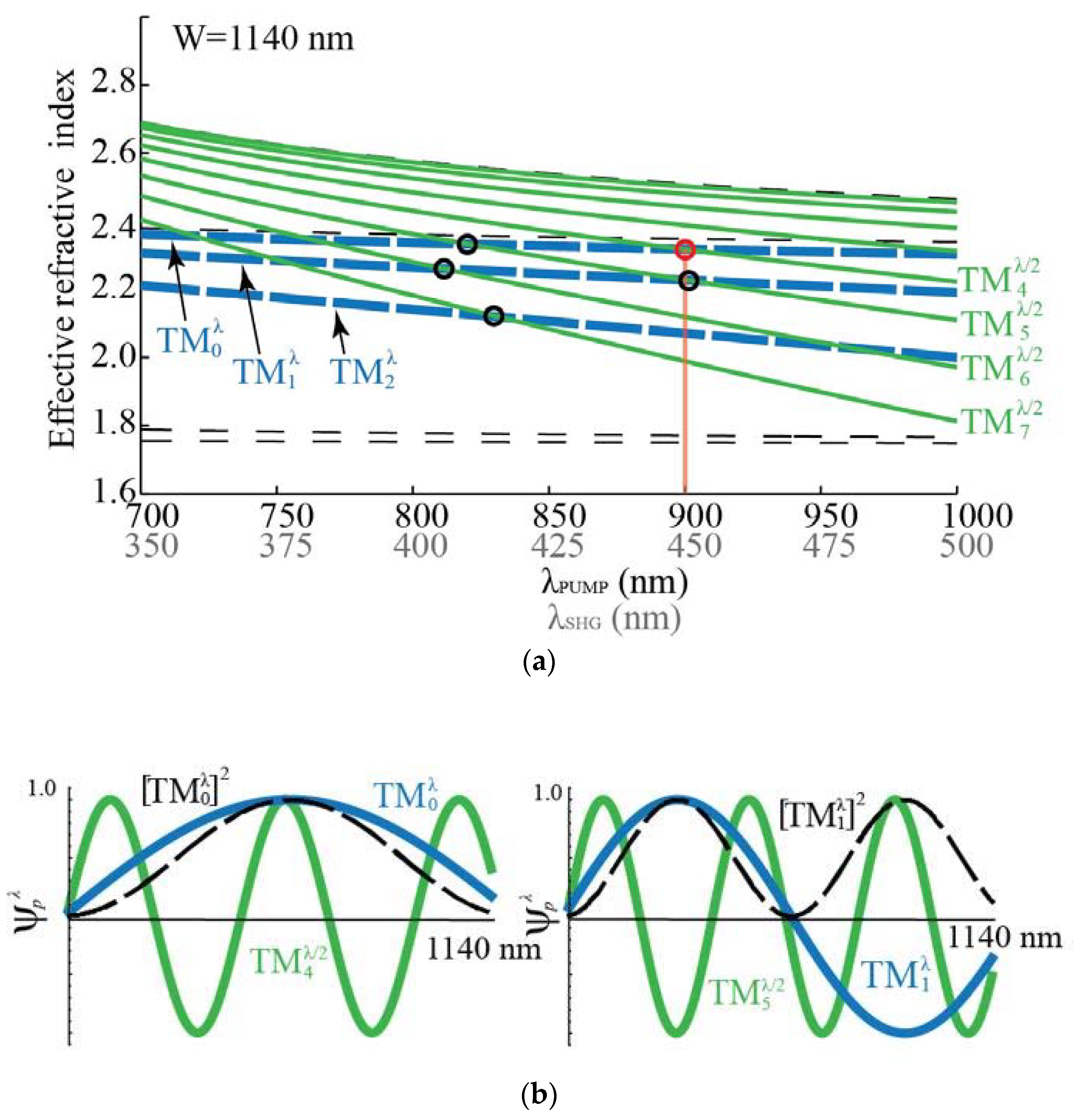Second-Harmonic Generation of Blue Light in GaN Waveguides
Abstract
:Featured Application
Abstract
1. Introduction
2. Materials and Methods
3. Results and Discussion
4. Conclusions
Author Contributions
Funding
Conflicts of Interest
References
- Nakamura, S.; Pearton, S.; Fasol, G. The Blue Laser Diode, 2nd ed.; Springer: Berlin, Germany, 2000. [Google Scholar]
- Morkoc, H. Nitride Semiconductors and Devices; Springer: New York, NY, USA, 1999. [Google Scholar]
- Paschotta, R. Encyclopedia of Laser Physics and Technology, 1st ed.; Wiley-VCH: Berlin, Germany, 2008. [Google Scholar]
- Silfvast, T.W. Laser Fundamentals, 2nd ed.; Cambridge University Press: New York, NY, USA, 2004. [Google Scholar]
- Taniyasu, Y.; Kasu, M.; Makimoto, T. An aluminium nitride light-emitting diode with a wavelength of 210 nanometres. Nature 2006, 441, 325–328. [Google Scholar] [CrossRef] [PubMed]
- Fischer, A.J.; Allerman, A.A.; Crawford, M.H.; Bogart, K.H.A.; Lee, S.R.; Kaplar, R.J.; Chow, W.W.; Kurtz, S.R.; Fullmer, K.W.; Figiel, J.J. Room-temperature direct current operation of 290 nm light-emitting diodes with milliwatt power levels. Appl. Phys. Lett. 2004, 84, 3394. [Google Scholar] [CrossRef]
- Zhang, H.Y.; He, X.H.; Shih, Y.H.; Schurman, M.; Feng, Z.C.; Stall, R.A. Study of nonlinear optical effects in GaN:Mg epitaxial film. Appl. Phys. Lett. 1996, 69, 2953. [Google Scholar] [CrossRef]
- Nishida, T.; Saito, H.; Kobayashi, N. Efficient and high-power AlGaN-based ultraviolet light-emitting diode grown on bulk GaN. Appl. Phys. Lett. 2001, 79, 711. [Google Scholar] [CrossRef]
- Kneissl, M.; Kolbe, T.; Chua, C.; Kueller, V.; Lobo, N.; Stellmach, J.; Knauer, A.; Rodriguez, H.; Einfeldt, S.; Yang, Z.; et al. Advances in group III-nitride-based deep UV light-emitting diode technology. Semicond. Sci. Technol. 2011, 26, 014036. [Google Scholar] [CrossRef]
- Kneissl, M.; Yang, Z.; Teepe, M.; Knollenberg, C.; Schmidt, O.; Kiesel, P.; Johnson, N.M.; Schujman, S.; Schowalter, L.J. Ultraviolet semiconductor laser diodes on bulk AlN. J. Appl. Phys. 2007, 101, 123103. [Google Scholar] [CrossRef]
- Yoshida, H.; Kuwabara, M.; Yamashita, Y.; Takagi, Y.; Uchiyama, K.; Kan, H. AlGaN-based laser diodes for the short-wavelength ultraviolet region. New J. Phys. 2009, 11, 125013. [Google Scholar] [CrossRef]
- Xie, J.; Mita, S.; Bryan, Z.; Guo, W.; Hussey, L.; Moody, B.; Schlesser, R.; Kirste, R.; Gerhold, M.; Collazo, R.; et al. Lasing and longitudinal cavity modes in photo-pumped deep ultraviolet AlGaN heterostructures. Appl. Phys. Lett. 2013, 102, 171102. [Google Scholar] [CrossRef]
- Yoshida, H.; Yamashita, Y.; Kuwabara, M.; Kan, H. A 342-nm ultraviolet AlGaN multiple-quantum-well laser diode. Nat Photonics 2008, 2, 551–554. [Google Scholar] [CrossRef]
- Collazo, R.; Mita, S.; Xie, J.; Rice, A.; Tweedie, J.; Dalmau, R.; Sitar, Z. Implementation of the GaN lateral polarity junction in a MESFET utilizing polar doping selectivity. Phys. Status Solidi A 2010, 207, 45–48. [Google Scholar] [CrossRef]
- Jeon, S.-R.; Ren, Z.; Cui, G.; Su, J.; Gherasimova, M. Investigation of Mg doping in high-Al content p-type AlxGa1−xN (0.3 < x < 0.5). Appl. Phys. Lett. 2005, 86, 082107. [Google Scholar]
- Dalmau, R.; Moody, B.; Schlesser, R.; Mita, S.; Xie, J.; Feneberg, M.; Neuschl, B.; Thonke, K.; Collazo, R.; Rice, A.; et al. Growth and Characterization of AlN and AlGaN Epitaxial Films on AlN Single Crystal Substrates. J. Electrochem. Soc. 2011, 158, H530. [Google Scholar] [CrossRef]
- Chowdhury, A.; Ng, H.M.; Bhardwaj, M.; Weimann, N.G. Second-harmonic generation in periodically poled GaN. Appl. Phys. Lett. 2003, 83, 1077. [Google Scholar] [CrossRef]
- Strite, S.; Morkoc, H. GaN, AlN, and InN: A review. J. Vac. Sci. Technol. B Microelectron. Nanometer Struct. 1992, 10, 1237–1266. [Google Scholar] [CrossRef]
- Pezzagna, S.; Brault, J.; de Micheli, M.; Vennegues, P.; Wieck, A.D.; Massies, J. GaN, a new material for integrated nonlinear optics. Proc. ECIO 2007, 25–27. [Google Scholar]
- Rigler, M.; Buh, J.; Hoffmann, M.P.; Kirste, R.; Bobea, M.; Mita, S.; Gerhold, M.D.; Collazo, R.; Sitar, Z.; Zgonik, M. Optical characterization of Al- and N-polar AlN waveguides for integrated optics. Appl. Phys. Express 2015, 8, 042603. [Google Scholar] [CrossRef]
- Rigler, M.; Zgonik, M.; Hoffmann, M.P.; Kirste, R.; Bobea, M.; Collazo, R.; Sitar, Z.; Mita, S.; Gerhold, M. Refractive index of III-metal-polar and N-polar AlGaN waveguides grown by metal organic chemical vapor deposition. Appl. Phys. Lett. 2013, 102, 221106. [Google Scholar] [CrossRef]
- Hum, S.D.; Fejer, M.M. Quasi-phase matching. C. R. Phys. 2007, 8, 180–198. [Google Scholar] [CrossRef]
- Stutzmann, M.; Ambacher, O.; Eickhoff, M.; Karrer, U.; Lima Pimenta, A.; Neuberger, R.; Schalwig, J.; Dimitrov, R.; Schuck, P.; Grober, R. Playing with Polarity. Phys. Status Solidi B 2001, 228, 505–512. [Google Scholar] [CrossRef]
- Pliska, T.; Fluck, D.; Gunter, P. Second-Harmonic Generation in Ferroelectric Waveguides. In Nonlinear Optical Effects and Materials; Springer Series in Optical Sciences; Springer: New York, NY, USA, 2000; Volume 72. [Google Scholar]
- Blanc, D.; Bouchoux, A.M.; Plumereau, C.; Cachard, A.; Roux, J.F. Phase-matched frequency doubling in an aluminum nitride waveguide with a tunable laser source. Appl. Phys. Lett. 1995, 66, 659. [Google Scholar] [CrossRef]
- Troha, T.; Rigler, M.; Alden, D.; Bryan, I.; Guo, W.; Kirste, R.; Mita, S.; Gerhold, M.D.; Collazo, R.; Sitar, Z.; et al. UV second harmonic generation in AlN waveguides with modal phase matching. Opt. Mater. Express 2016, 6, 2014. [Google Scholar] [CrossRef]
- Kawano, K.; Kitoh, T. Introduction to Optical Waveguide Analysis: Solving Maxwell’s Equation and the Schrodinger Equation; Wiley-Interscience: New York, NY, USA, 2001. [Google Scholar]
- Eyges, L.; Gianino, P.; Wintersteiner, P. Modes of dielectric waveguides of arbitrary cross sectional shape. JOSA 1979, 69, 1226–1235. [Google Scholar] [CrossRef]
- Bass, M.; Mahajan, V.N.; Van Stryland, E.W. Handbook of Optics—Design, Fabrication, and Testing; Sources and Detectors; Radiometry and Photometry, 3rd ed.; McGraw-Hill, Inc.: New York, NY, USA, 2010; Volume II. [Google Scholar]
- Sanford, N.A.; Robins, L.H.; Davydov, A.V.; Shapiro, A.; Tsvetkov, D.V.; Dmitriev, A.V.; Keller, S.; Mishra, U.K.; DenBaars, S.P. Refractive index study of AxGa1-xN films grown on sapphire substrates. J. Appl. Phys. 2003, 94, 2980. [Google Scholar] [CrossRef]
- Liu, F.; Collazo, R.; Mita, S.; Sitar, Z.; Duscher, G.; Pennycook, S.J. The mechanism for polarity inversion of GaN via a thin AlN layer: Direct experimental evidence. Appl. Phys. Lett. 2007, 91, 203115. [Google Scholar] [CrossRef]
- Mita, S.; Collazo, R.; Sitar, Z. Fabrication of GaN lateral polarity junction by metalorganic chemical vapor deposition. J. Cryst. Growth 2009, 311, 3044–3048. [Google Scholar] [CrossRef]
- Kirste, R.; Mita, S.; Hussey, L.; Hoffmann, M.P.; Guo, W.; Bryan, I.; Bryan, Z.; Tweedie, J.; Xie, J.; Gerhold, M.; et al. Polarity control and growth of lateral polarity structures in AlN. Appl. Phys. Lett. 2013, 102, 181913. [Google Scholar] [CrossRef]
- Hoffman, M.P.; Gerhold, M.; Kirste, R.; Rice, A.; Akouala, C.R.; Xie, J.Q.; Mita, S.; Collazo, R.; Sitar, Z. Fabrication And Characterization of Lateral Polar GaN Structures for Second Harmonic Generation. Proc. SPIE 2013, 8631. [Google Scholar] [CrossRef]
- Guo, W.; Xie, J.; Akouala, C.; Mita, S.; Rice, A.; Tweedie, J.; Bryan, I.; Collazo, R.; Sitar, Z. Comparative study of etching high crystalline quality AlN and GaN. J. Cryst. Growth 2013, 366, 20–25. [Google Scholar] [CrossRef]
- Mita, S.; Collazo, R.; Rice, A.; Dalmau, R.F.; Sitar, Z. Influence of gallium supersaturation on the properties of GaN grown by metalorganic chemical vapor deposition. J. Appl. Phys. 2008, 104, 013521. [Google Scholar] [CrossRef]





| p = 0, q = 4, λ = 900 nm | 6.34 × 10−4 |
| p = 1, q = 5, λ = 900 nm | 1.81 × 10−5 |
| p = 0, q = 5, λ = 815 nm | 1.44 × 10−6 |
| p = 1, q = 6, λ = 810 nm | 1.83 × 10−3 |
| p = 2, q = 7, λ = 825 nm | 9.10 × 10−5 |
© 2018 by the authors. Licensee MDPI, Basel, Switzerland. This article is an open access article distributed under the terms and conditions of the Creative Commons Attribution (CC BY) license (http://creativecommons.org/licenses/by/4.0/).
Share and Cite
Rigler, M.; Troha, T.; Guo, W.; Kirste, R.; Bryan, I.; Collazo, R.; Sitar, Z.; Zgonik, M. Second-Harmonic Generation of Blue Light in GaN Waveguides. Appl. Sci. 2018, 8, 1218. https://doi.org/10.3390/app8081218
Rigler M, Troha T, Guo W, Kirste R, Bryan I, Collazo R, Sitar Z, Zgonik M. Second-Harmonic Generation of Blue Light in GaN Waveguides. Applied Sciences. 2018; 8(8):1218. https://doi.org/10.3390/app8081218
Chicago/Turabian StyleRigler, Martin, Tinkara Troha, Wei Guo, Ronny Kirste, Isaac Bryan, Ramon Collazo, Zlatko Sitar, and Marko Zgonik. 2018. "Second-Harmonic Generation of Blue Light in GaN Waveguides" Applied Sciences 8, no. 8: 1218. https://doi.org/10.3390/app8081218





